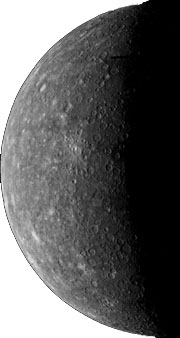geotimesheader
News
Notes
Planetary
Geology
Mission
to Mercury
| Twenty-five years ago, Mariner 10 flew past Mercury for the
second and final time. Since then the planet closest to the sun has orbited
center stage with no visits from its adoring fans on Earth. “I think NASA
had sort of forgotten about Mercury, although the scientific community
hadn’t,” says Mark Robinson of Northwestern University.
After Mariner 10, which saw only half of the planet, scientists
were left with knowledge about Mercury “similar to what we knew about the
Moon at the dawn of the space age: no compositional data and only 50 percent
of its view,” Robinson says. Mercury researchers had to interpret data
using “Earth-based, geologic common sense to read between the lines.”
The planet has since been rediscovered. Radar imaging techniques have
improved to provide scientists with intriguing information about the unseen
side of the Moon-sized planet. At the American Geophysical Union meeting
in June, American and European scientists presented their plans for the
next mission to Mercury: the Messenger spacecraft, scheduled to
launch in 2004. Messenger will use two flybys past Venus and Mercury
to slow down before entering an elliptical orbit in 2009. |

Mariner
10 image mosaic
of Mercury. |
“If we’re going to go into orbit around Mercury then we’re going to have
to worry about the thermal environment of the planet,” says Ralph McNutt
Jr. of The Johns Hopkins University Applied Physics Laboratory. Design
plans aim to keep the body of the spacecraft cool under a thermal shield
as Messenger spends two solar days or four Mercury years (about
one Earth year) in orbit around the planet.
The spacecraft’s vantage point will allow it to map the entire planet
and also provide close scrutiny of the stream of accelerated particles
coming from the sun. Understanding the origin and nature of the planet’s
magnetic field and how its thin atmosphere reacts to the sun’s blasting
solar wind will be vital for the mission, said Lynn Burlaga of NASA’s Goddard
Space Flight Center in Maryland. “Solar wind will interact with Mercury
more strongly than Earth, by a factor of two to 10 at least.”
With a suite of spectrometers and a visible infrared spectrograph,
Messenger
will also investigate the composition of the surface to test hypotheses
about Mercury’s high density and the origin of its core — considered rich
in iron and extremely large for its volume as a terrestrial planet. It
is unknown if the scorching heat of an early sun vaporized the planet’s
outer mantle, leaving very few volatile elements like potassium in the
crust, or if Mercury formed more like a dirty snowball rolling through
the solar nebula, picking up grains rich in heavy metals along the way.
Another idea suggests a giant impact event stripped the planet, soon
after it formed, of normal crustal elements such as aluminum. But this
third alternative seems less likely considering that Earth’s early Moon-forming
impact event kicked out a massive portion of material but did not appreciably
affect the size of the mantle in relationship to its core, says William
Boynton of the University of Arizona. Also, Mercury has no moon to offer
in support of such an event.
Messenger will also investigate the volcanic nature of the planet,
indications of tectonic deformation, the source of the planet’s magnetic
field, the possible existence of a liquid core and what the mysterious
radar reflecting material is at the poles. Radar images of Mercury’s north
pole in 1991 and south pole in 1994 appeared like fireworks in a dark sky,
indicating to scientists at NASA’s Jet Propulsion Laboratory and Arecibo
Observatory that Mercury sheltered frozen water permanently in shadow along
high rims of its polar craters. Messenger will check for enhanced
sulfur or hydrogen to resolve the debate between scientists who believe
the material is indeed frozen water and others who suggest it is a result
of extreme surface temperature differences or perhaps an indication of
elemental sulfur.
European scientists plan to complement the Messenger mission with their
own possible launch of a probe in 2007. The BepiColombo spacecraft
concepts include a lander with a microrover and drilling device, says Rejean
Grard of the European Space Agency in the Netherlands. Exploring Mercury,
he says, may provide key insights for understanding the formation of terrestrial
planets.
Christina Reed

